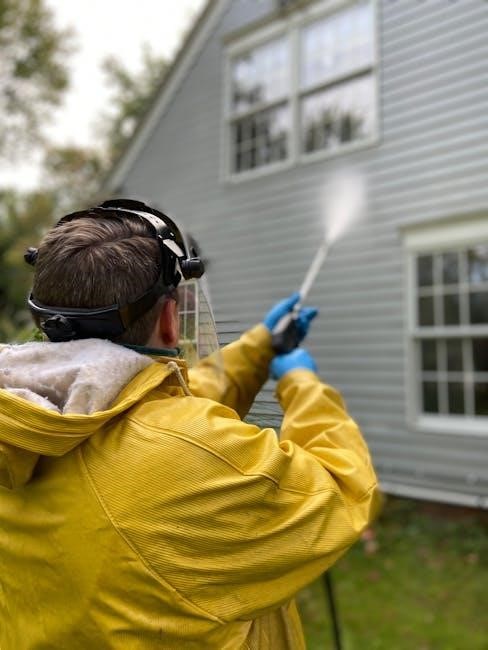Welcome to your pressure washer manual, your essential guide for safe and effective operation. This manual provides comprehensive instructions, safety tips, and maintenance advice to ensure optimal performance and longevity of your equipment, helping you achieve professional cleaning results while protecting both you and your investment.
1.1 Importance of Reading the Manual

Reading your pressure washer manual is crucial for safe and effective operation. It provides essential safety precautions, assembly instructions, and maintenance tips to prevent accidents and equipment damage. The manual outlines proper usage guidelines, warranty information, and troubleshooting steps, ensuring you understand your machine’s capabilities and limitations. By following the manual, you can avoid costly repairs, extend the lifespan of your pressure washer, and achieve optimal cleaning results. Always prioritize reading the manual before use to protect yourself and your investment.
1.2 Key Components of a Pressure Washer Manual
A pressure washer manual typically includes essential sections like safety precautions, assembly instructions, and maintenance schedules. It also covers troubleshooting guides, technical specifications, and environmental considerations. The manual provides detailed diagrams and step-by-step instructions for proper usage, ensuring users understand how to operate the machine safely and effectively. Additionally, it outlines warranty information, parts compatibility, and disposal guidelines. By organizing this information clearly, the manual serves as a comprehensive resource for owners to maximize their pressure washer’s performance and lifespan while adhering to safety and environmental standards.

Safety Precautions and Warnings
This section outlines essential safety measures to prevent accidents and ensure safe operation of your pressure washer. Always follow the guidelines provided to minimize risks and protect yourself and others while using the equipment.
2.1 General Safety Guidelines
Always read and follow the safety guidelines in your pressure washer manual to ensure safe operation. Never put your hands, fingers, or body in front of the spray nozzle. Wear protective eyewear and avoid loose clothing that could get caught. Keep children and pets away while operating the machine. Be cautious of hot surfaces and ensure the area is clear of obstacles. Maintain a firm grip on the spray gun and avoid using the washer in wet conditions. Regularly inspect hoses and connections for damage. Follow all warnings and instructions provided to minimize risks and prevent accidents. Proper adherence to these guidelines ensures a safe and effective cleaning experience.
2.2 Hazard Prevention Tips
To prevent hazards when using a pressure washer, always ensure the machine is on a stable, level surface. Avoid using it near open flames or sparks, as some models may produce flammable emissions. Never aim the nozzle at people, animals, or windows, as the high-pressure jet can cause injury or damage. Use the correct nozzle size and pressure setting for the task to avoid unintended force. Keep the washer and hose away from hot surfaces and chemicals. Regularly check for worn or damaged parts and replace them promptly. Store the machine in a cool, dry place when not in use. Following these tips helps minimize risks and ensures safe operation.
2.3 Warning Labels and Symbols
Pressure washer manuals include warning labels and symbols to alert users of potential hazards. These labels are often located on the machine itself and in the manual. Common symbols include a flammable liquid warning, electrical hazard alert, and crushed hand hazard. Each symbol is accompanied by a brief explanation to ensure understanding. Users should inspect the machine for these labels and not remove them. Specific symbols may indicate high-pressure jets, hot surfaces, or moving parts. Always refer to the manual for a detailed explanation of each symbol. Ignoring these warnings can lead to injury or damage. Adhere to the instructions provided to ensure safe operation and avoid accidents.
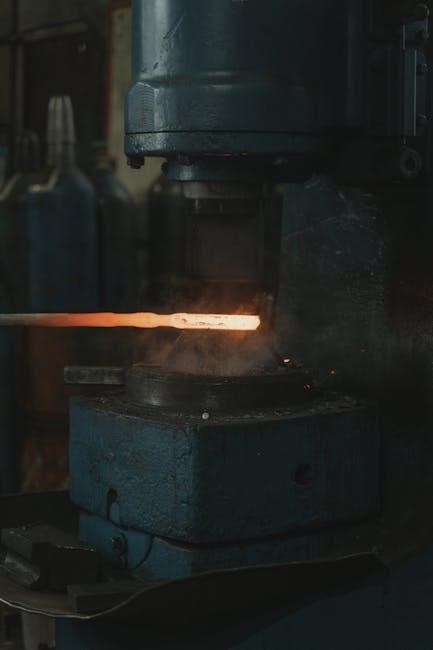
Assembly and Installation
Assembly and installation are critical steps to ensure proper function. Follow the manual’s guide for unpacking, attaching hoses, and securing accessories. Ensure all parts are correctly fitted.
3.1 Unpacking and Inventory
Begin by carefully unpacking the pressure washer and all included accessories. Check for any visible damage during unpacking. Compare the contents with the manual’s inventory list to ensure all parts are present. Familiarize yourself with each component, such as the washer unit, hose, spray gun, nozzles, and power cord. Organize the parts logically to avoid misplacement. Verify that all small accessories, like bolts or adapters, are accounted for. If any items are missing or damaged, contact the supplier immediately. Proper unpacking ensures a smooth assembly process and prevents delays. Always refer to the manual for specific unpacking instructions tailored to your model.
3.2 Initial Setup and Preparation
After unpacking, begin by placing the pressure washer on a level, stable surface. Refer to the manual for specific placement recommendations. Inspect all components for damage or defects. Attach any pre-assembled parts according to the manual’s instructions. Ensure the washer is on a firm, non-slip surface to prevent movement during operation. Check the power source and water supply connections to confirm compatibility. Familiarize yourself with the control panel and essential features. Prime the pump if required, as outlined in the manual. Fill the detergent tank with the recommended cleaning solution, avoiding overfilling. Double-check all connections and settings before starting the machine. Proper preparation ensures safe and efficient operation. Always follow the manufacturer’s guidelines for initial setup.
3.3 Connecting the Hose and Accessories
Attach the high-pressure hose to the pump and spray gun securely. Ensure all connections are tight to prevent leaks. Use the correct nozzle or tip for your cleaning task, as specified in the manual. If using accessories like detergent injectors or brushes, connect them according to the manufacturer’s instructions. Always check for any blockages in the hose or accessories before use. Properly align and tighten all fittings to avoid damage from high pressure. Consult the manual for specific torque settings or tools required. Double-check connections for leaks by running the machine at low pressure for a few seconds. Ensure all accessories are compatible with your pressure washer model for optimal performance and safety. Always follow the manufacturer’s guidelines for connecting accessories.

Operating the Pressure Washer
Operate the pressure washer safely and efficiently by following the guidelines in your manual. Always check settings, use proper techniques, and ensure accessories are correctly attached for optimal performance.
4.1 Starting the Machine
Starting the pressure washer requires careful preparation to ensure safety and optimal performance. Begin by reading the manual to understand the specific startup procedure. Always check the oil level, coolant, and fuel before initiating operation. Ensure the water supply is connected properly and the hose is free from kinks or blockages. Prime the pump according to the manufacturer’s instructions to prevent cavitation. Once ready, turn the engine switch to the “on” position and pull the starter cord or press the ignition button. Allow the machine to warm up briefly before adjusting the pressure settings. Always wear protective gear and ensure the area is clear of obstacles or bystanders. Follow the manual’s guidelines for a smooth startup and refer to troubleshooting tips if issues arise. Proper startup ensures efficient cleaning and reduces wear on the machine.
4.2 Adjusting Pressure Settings
Adjusting the pressure settings on your pressure washer is crucial for achieving the desired cleaning results while protecting surfaces. Locate the pressure regulator, typically found near the pump or wand. Refer to the manual for specific instructions, as controls may vary by model. Turn the regulator clockwise to increase pressure and counterclockwise to decrease it. Always start with a lower setting and gradually increase as needed. Be cautious not to exceed the recommended PSI for the surface being cleaned. Use the correct nozzle or tip for the selected pressure setting. Wearing safety goggles is essential when adjusting settings. Regularly check the pressure gauge to ensure it aligns with your manual’s guidelines. Proper adjustment ensures efficiency and prevents damage to surfaces or equipment. Always test a small, inconspicuous area first to verify the setting is appropriate. Adjustments should be made with the engine running to ensure accuracy. Maintain a safe distance from the nozzle to avoid injury. Keep the manual handy for quick reference during adjustments. This step ensures optimal performance and safety during use. Proper pressure adjustment enhances cleaning effectiveness and prolongs the life of your pressure washer. Refer to the manual for model-specific instructions and safety precautions. Avoid over-pressurizing, as it may damage the machine or the surface. Always store the pressure washer with the regulator in the lowest setting to prevent accidental start-ups. By following these steps, you can customize the pressure to suit various cleaning tasks. Adjusting settings correctly ensures a safe and efficient cleaning experience. Remember, the right pressure setting is key to achieving professional-grade results without causing harm. Adjust wisely and clean effectively with your pressure washer.
4.3 Using Different Nozzles and Tips
Using the correct nozzles and tips is essential for effective and safe pressure washing. Most pressure washers come with interchangeable nozzles, each designed for specific tasks. The red nozzle delivers a high-pressure, narrow stream for tough stains, while the yellow nozzle offers a slightly wider spray for general cleaning. The green nozzle provides a wide fan tip for delicate surfaces, and the black nozzle is used for applying detergents. To change nozzles, ensure the machine is off, then twist and pull the current tip. Always use the nozzle recommended in your manual for the task. Wearing safety goggles is crucial when testing a new tip. Store unused nozzles securely to prevent loss or damage. Using the right nozzle enhances cleaning efficiency and prevents surface damage. Regularly inspect nozzles for wear and replace them as needed. Keep children away when changing tips. Proper nozzle selection ensures optimal performance and safety. Refer to your manual for compatibility and usage guidelines. This step ensures you achieve the best results for every cleaning job. Always prioritize safety and efficiency when selecting and using nozzles and tips. Cleaning becomes easier with the right accessories. Use nozzles wisely to maximize your pressure washer’s potential.

Maintenance and Care
Regular maintenance ensures optimal performance. Check and replace the filter, drain old fuel, lubricate moving parts, and inspect hoses for damage. Proper care extends the lifespan.
5.1 Regular Maintenance Schedule
A regular maintenance schedule is crucial for optimal performance. Check the filter monthly and replace it if clogged. Drain old fuel at the end of each season. Lubricate moving parts every 50 hours of use. Inspect hoses and connections for damage or leaks. Clean the exterior to prevent dirt buildup. Check the pump for signs of wear or leakage. Replace worn seals or O-rings promptly. Follow a pre-use checklist to ensure everything is in working order. Store the pressure washer in a dry, protected area during winter. Regular maintenance prevents breakdowns and extends the lifespan of your pressure washer. Always refer to the manual for specific schedules tailored to your model.
5.2 Winterizing the Pressure Washer
Winterizing your pressure washer is essential to prevent damage from freezing temperatures. Drain all water from the pump, hose, and tank. Use a pump saver or RV antifreeze to protect internal components. Disconnect hoses and store them separately. If your model has a gas engine, stabilize the fuel and drain the tank or run it dry. Store the pressure washer in a dry, heated area or cover it securely outdoors. Avoid leaving water in the system, as ice formation can cause cracks or ruptures. Inspect for any damage before storage and address issues promptly. Proper winterization ensures your pressure washer remains functional and ready for use in the spring.
5.3 Replacing Parts and Accessories
Replacing parts and accessories on your pressure washer requires careful attention to compatibility and safety. Always use genuine or manufacturer-recommended replacement parts to ensure optimal performance. Turn off and unplug the machine, then allow it to cool before starting any replacement. Disconnect the power source and drain all water from the system. For specific parts like hoses, nozzles, or spray guns, refer to the manual for removal and installation instructions. Tighten all connections securely but avoid over-tightening, which could damage threads. Regularly inspect and replace worn or damaged seals, O-rings, or other wearable components to maintain efficiency. Proper replacement ensures safety, extends the lifespan of your pressure washer, and prevents costly repairs.
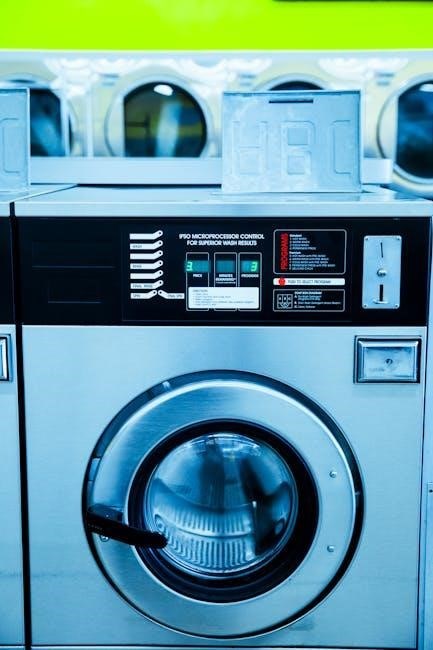
Troubleshooting Common Issues
Common issues like low pressure, machine not starting, or overheating can often be resolved by checking fuel levels, verifying power supply, and ensuring proper hose connections. Always refer to the manual for specific diagnostic steps and solutions to avoid further damage. Regular maintenance and adherence to manufacturer guidelines can help prevent many of these issues, ensuring safe and efficient operation.
6.1 Identifying Common Problems
Common issues with pressure washers often include low water pressure, the machine not starting, or overheating. These problems can usually be identified by observing symptoms such as weak water flow, no engine ignition, or unusual noises. Leaks, blocked hoses, or faulty nozzles are also frequent concerns. Users should consult the manual to match symptoms with potential causes, ensuring proper diagnosis. Paying attention to error indicators or unusual operational behavior can help in early detection. Regular checks and maintenance can prevent many of these issues, but when they arise, systematic troubleshooting is essential for effective resolution and to maintain the equipment’s performance.
6.2 Diagnostic Steps for Malfunction
To diagnose a malfunctioning pressure washer, start by checking the power source and ensuring all connections are secure; Verify fuel levels if it’s a gas-powered model and ensure the oil is at the recommended level. Inspect the air filter for cleanliness and the spark plug for proper function. Next, examine the water supply, ensuring it’s turned on and the hose isn’t kinked or blocked. Check for any leaks in the pump or hoses. If the issue persists, consult the manual to locate the specific component causing the problem. Use the troubleshooting guide to isolate the fault, such as testing the spray gun or checking for nozzle obstructions. Systematic diagnosis helps pinpoint the root cause efficiently.
6.3 Resetting the Pressure Washer
Resetting your pressure washer can resolve operational issues caused by system glitches or overloads. Start by turning off the machine and unplugging it from the power source. Locate the reset button, typically found near the motor or control panel, and press it firmly for 5-10 seconds. For gas-powered models, ensure the fuel tank is empty before resetting. Once reset, reconnect the power and test the machine on a low setting. If issues persist, refer to the manual for specific reset procedures, as they may vary by model. Always follow safety guidelines when resetting to avoid further malfunctions or damage.
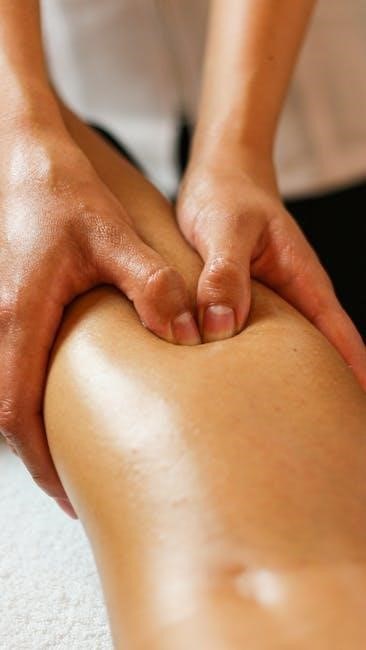
Technical Specifications
Understand your pressure washer’s performance capabilities, including PSI and GPM ratings, engine power, and pump efficiency. Compatibility with accessories ensures optimal functionality and safety.
7.1 Understanding PSI and GPM Ratings
PSI (Pounds per Square Inch) measures the pressure washer’s cleaning power, while GPM (Gallons per Minute) indicates water flow rate. Higher PSI is ideal for heavy-duty tasks, but lower settings may be sufficient for delicate surfaces. GPM affects cleaning efficiency, with higher flow rates speeding up tasks. Always check your manual for recommended PSI and GPM settings for specific jobs to avoid damage. Properly matching these ratings ensures effective cleaning and equipment longevity. Understanding these specifications helps you choose the right nozzle and settings for optimal performance. Refer to your manual for detailed guidance on adjusting these settings safely and effectively.
7.2 Engine and Pump Specifications
The engine and pump are the heart of your pressure washer, determining its performance and longevity. The manual provides detailed specs, such as engine type (gas, electric, or diesel), horsepower, and pump kind (axial, radial, or triplex). Pump specs include displacement (in liters per minute) and maximum pressure; These details ensure compatibility with accessories and help maintain optimal performance. Properly matching engine and pump specs to your cleaning needs prevents overload and extends lifespan; Always refer to your manual for specific recommendations to ensure safe and efficient operation. Understanding these components helps you make informed decisions for maintenance and upgrades.
7.3 Compatibility with Accessories
Your pressure washer manual outlines compatibility with various accessories, ensuring optimal performance. It specifies compatible hose lengths, diameters, and materials, as well as nozzle types and sizes. Detergent injectors and spray guns are also covered, with details on flow rates and pressure limits. Using incompatible accessories can damage the machine or reduce efficiency. The manual provides guidelines for selecting the right attachments based on your unit’s PSI and GPM ratings. Always check compatibility charts or tables in the manual to avoid mismatches. Proper accessory selection enhances cleaning effectiveness and extends the lifespan of your pressure washer.
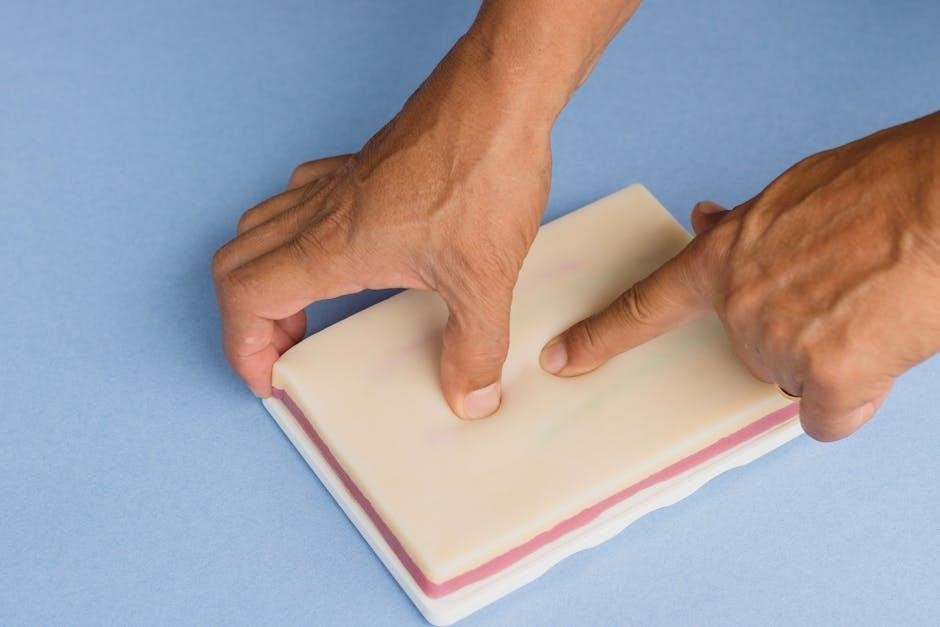
Environmental Considerations
Proper disposal of chemicals and water conservation are emphasized. Eco-friendly practices, like using biodegradable cleaners, are encouraged to minimize environmental impact and promote sustainable cleaning habits.
8.1 Proper Disposal of Chemicals
Always dispose of pressure washer chemicals responsibly. Check local regulations for hazardous waste collection facilities. Never pour chemicals down drains or storm sewers, as they can harm water ecosystems. Use biodegradable detergents when possible. Store chemicals in original containers with labels intact. Refer to Safety Data Sheets (SDS) for specific disposal instructions. Avoid mixing different chemicals to prevent dangerous reactions. Ensure all liquids are sealed tightly to prevent leaks during transport. Participate in community collection events for hazardous materials. Proper disposal protects the environment and complies with legal requirements. Encourage eco-friendly practices to minimize chemical impact on nature.
8.2 Water Conservation Tips
Conserving water while using a pressure washer is essential for environmental sustainability. Use low-flow nozzles to reduce water usage without compromising cleaning efficiency. Adjust pressure settings to the minimum required for the task to minimize water flow. Always turn off the washer when not in use to avoid unnecessary water waste. Use eco-friendly detergents at recommended concentrations to reduce runoff and protect waterways. Regularly inspect hoses and connections for leaks to prevent water loss. Consider recycling water for non-critical cleaning tasks where possible. Promote water conservation by adhering to these practices, ensuring responsible use of this valuable resource while maintaining cleaning effectiveness.
8.3 Eco-Friendly Cleaning Practices
To adopt eco-friendly cleaning practices with your pressure washer, prioritize environmentally responsible methods. Use biodegradable or phosphate-free detergents to minimize harm to waterways and wildlife. Avoid excessive chemical use by applying detergents directly to surfaces and rinsing thoroughly. Opt for lower pressure settings when possible to reduce water and energy consumption. Regularly maintain your equipment to ensure efficiency and prevent waste. Dispose of cleaning solutions and wastewater responsibly, adhering to local regulations. By integrating these practices, you can effectively clean while protecting the environment and promoting sustainability. Eco-conscious cleaning not only benefits the planet but also supports long-term resource conservation.
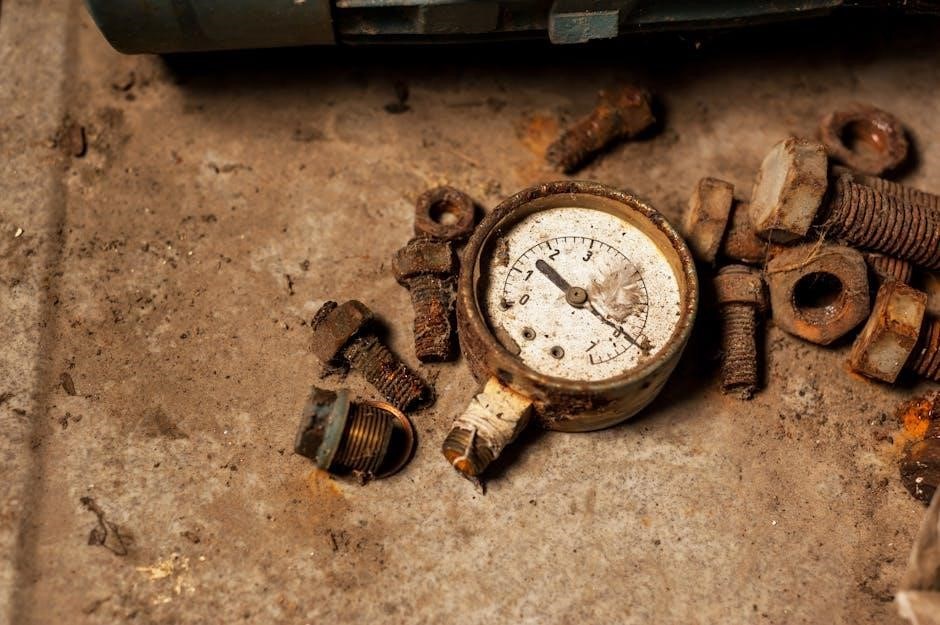
Additional Resources
Explore online support for troubleshooting, FAQs, and detailed guides. Download manuals and user guides for quick reference. Contact customer service for personalized assistance and inquiries.
9.1 Online Support and FAQs
Access comprehensive online support and FAQs for your pressure washer through the manufacturer’s official website. These resources offer detailed answers to common questions, troubleshooting tips, and guidance on operation and maintenance. FAQs cover topics like initial setup, pressure adjustment, and accessory usage. Troubleshooting sections help identify and resolve issues such as low pressure or engine problems. Video tutorials and downloadable guides are often available to enhance understanding. Users can search by keywords or browse categories for quick solutions. These online tools are designed to provide convenient, 24/7 support, ensuring optimal performance and addressing concerns efficiently. Regular updates keep the information current and relevant.
9.2 Downloading Manuals
Downloading a pressure washer manual is a straightforward process that ensures you have access to essential information anytime; Most manufacturers provide digital versions of their manuals on their official websites. To download, visit the manufacturer’s site, navigate to the support or resources section, and search for your specific model. Manuals are often available in PDF format, which can be easily saved to your device. Ensure your device has a PDF reader installed to view the document. Always download from authorized sources to avoid unauthorized or outdated versions. If you encounter issues, check your internet connection or contact customer support for assistance. Updated manuals are regularly posted, so verify the version matches your pressure washer model for accuracy.
9.3 Contacting Customer Service
Contacting customer service is an essential step when you need personalized assistance with your pressure washer. Most manufacturers provide multiple contact methods, such as phone, email, or live chat, to address your inquiries. Visit the official website and locate the “Contact Us” section for details. Ensure you have your model number and a clear description of your issue ready to expedite support. Many companies also offer support tickets or online forms for convenience. Response times may vary, so check the website for estimated turnaround periods. For urgent matters, phone support is often the fastest option. Always verify contact information is from an official source to avoid unauthorized representatives.
This comprehensive guide provides essential insights for safe, effective, and responsible pressure washer usage. Always follow manual instructions for optimal performance and longevity of your equipment.
10.1 Summary of Key Points
This guide emphasizes the importance of understanding your pressure washer manual for safe and efficient operation. Key points include adhering to safety precautions, proper assembly, and regular maintenance. Always follow guidelines for starting the machine, adjusting pressure settings, and using appropriate nozzles. Troubleshooting common issues and understanding technical specifications ensure optimal performance. Environmental considerations, such as proper chemical disposal and water conservation, promote eco-friendly usage. By following these steps, you can extend the lifespan of your pressure washer and ensure reliable results. Remember, safety and adherence to manual instructions are paramount for a positive user experience.
10.2 Encouragement for Safe Usage
Prioritizing safety is essential for optimal performance and longevity of your pressure washer. Always wear protective gear, such as gloves and goggles, to minimize risks. Follow the manual’s guidelines for proper usage and avoid shortcuts that could lead to accidents. Regular maintenance ensures the machine operates efficiently and safely. Be mindful of environmental impact by using eco-friendly practices and responsible water usage. Safe operation not only protects you but also extends the life of your equipment. By adhering to these practices, you can enjoy a hassle-free cleaning experience while maintaining a safe and sustainable approach to pressure washing.
